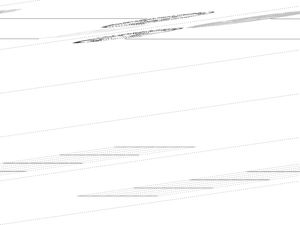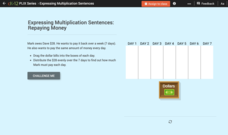Federal Reserve Bank
Money and Inflation: A Functional Relationship
What is the difference between money and bartering, and how is money valued when considering inflation? Delve into the correlation between these fundamental components of economics with this detailed resource, which consists of...
Curated OER
Clean up the Money!
In this money worksheet, students fill up a grid with coins and then roll dice to get ordered pairs and take the money of the ordered pair that they roll. Students then add up their money in the end and see who wins.
CK-12 Foundation
Whole Number Division: Repaying Money
Mathematicians answer five word problems in an interactive practice all about repaying money using division. A calendar and moveable dollar bills aides participants in finding solutions to multiple-choice, fill-in-the-blank, and...
Creative Chemistry
What is the Percentage of Copper in "Copper" Coins?
Whether in the UK or the US, the mass of the copper in a copper alloy penny can be determined. If you are in the US, note that on the lab sheet, a penny is identified as a "1p piece." The penny is dissolved by young chemists in nitric...
Curated OER
Money
For this money worksheet, learners read different forms of money, choose the correct name for different forms of money, complete a crossword, and more. Students complete 5 activities.
College Board
2010 AP® Macroeconomics Free-Response Questions Form B
Currency depreciation, technology, an increase in the price of oil, or an increase in consumer spending have powerful impacts on an economy. Learners evaluate these effects using authentic materials from College Board. Other questions...
Curated OER
Understanding the Effects of Currency Exchange Rates
In this algebra activity, students match the currency with the country of origin. They convert between that currency and the US using a foreign exchange conversion table. There are 35 questions.
Curated OER
Adding Decimals
Explore the practical uses of adding numbers with decimals as scholars add measurements and money. The first 12 equations are written vertically with half the sums requiring a dollar sign and half a unit of measurement. The next six are...
Curated OER
Verb Forms: Second Conditional
Which verb tenses can you use when writing with the conditional tense? Clear up the common mistakes with this second conditional instructional activity. Young writers choose the correct verb tense to complete a sentence. They choose from...
Curated OER
Math Cross--Puzzle #10
In this money learning exercise, students fill in a crossword puzzle as they solve twenty-eight math problems dealing with different forms of money intertwined into addition, subtraction and multiplication problems.
DK Publishing
Money Word Problems #3
Money is an excellent way to help young mathematicians practice adding and subtracting numbers with decimals. They solve 15 word problems representing a variety of scenarios for calculating money. For some, scholars determine which bills...
CK-12 Foundation
Counting Events: Flipping Unfair Coins
Who said life was fair? An interactive uses an area diagram to represent the probabilities of flipping unfair coins. Pupils use the diagram to calculate the probabilities of outcomes of flipping the two coins. The scholars must decide...
CK-12 Foundation
Domain and Range of a Function: Making Money Math
Graphs are useful for many things, including seeing how much money you can make. Individuals create a graph of earnings from a job based on the number of hours. They determine the domain and range of the graph and answer challenge...
CK-12 Foundation
Solving Equations with Exponents: Money Over Time
We'd all like to see our money double. An interactive shows how an initial investment of $1,000 will increase using a constant rate of return. Scholars answer a set of challenge questions based on the situation.
CK-12 Foundation
Mode: Mucho Money
Generate stacks of money. Given bills of different denominations, pupils stack them based on their values. The learners figure out which value is the mode of the data and determine whether the data is unimodal, bimodal, or multimodal.
Curated OER
Can You Write the Coin's Name?
For this coin identification worksheet, students trace the dotted lines to form the names of the coin amounts such as 10 p, 20 p, and 5p. They draw a line from the pictures of the coins to the proper name.
K5 Learning
Mixed Practice Word Problems #5
Six word problems make up this mixed practice activity. Pupils work with money, adding, subtracting, multiplying, and dividing using numbers up to 250.
K5 Learning
Mixed Practice Word Problems #8
Six questions make up a mixed practice learning exercise. Scholars use their knowledge of addition, subtraction, multiplication, money, perimeter, ounces, and pounds to solve word problems with numbers up to 66,000.
Palomar College
Making Yes/No Questions in the Present Tense
Does your class need some practice with writing yes or no questions in the present tense? This learning exercise offers learners some choice as they pair activities with subjects to form questions. Pupils also write a quick response to...
Curated OER
Money Amounts
In this consumer math worksheet, students write the amount of money they see in decimal form. They identify and total both paper money and coins in 4 examples. They identify bills up to $100 and coins from a penny to a dollar.
Curated OER
Vocabulary Lesson: Money - Worksheet 5
In this money vocabulary learning exercise, learners fill in the blanks in 6 sentences using the word bank at the top of the page. They use words such as inherit, borrow, steal, waste, and withdraw.
Curated OER
Money word problems
In this money worksheet, learners complete word problems where they add, subtract, round, and more with money amounts. Students complete 10 problems.
Curated OER
Write the Money in Decimal Form
In this consumer math worksheet, learners total the monetary amounts using both paper money and coins in 4 examples. They work with paper money up to $50 bill and coins up to quarters.
Curated OER
First Conditional Verb Form
In this perfect English grammar worksheet, student fill in the blanks with the first conditional form of the given verb. They complete 24 questions that each contain 2 blanks in which they write the correct verb form.























